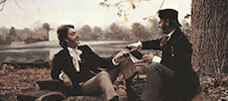Reviews
Arthur Penn
USA, 1969
Credits
Review by David Carter
Posted on 09 December 2010
Source MGM Home Video DVD
Categories Rock Follies
Arthur Penn captured one aspect of the spirit of the sixties - its glamorous, violent anti-authoritarianism - with Bonnie and Clyde, a commercial and critical success that redefined American cinema. That film translated counterculture angst into violence in a tale that is both liberating and repressive; the young lovers are allowed to briefly give the status quo its comeuppance, but are ultimately killed for transgressing society’s laws. At first glance, Penn’s follow up, the pastoral comedy Alice’s Restaurant, seems to be a great departure from the hyper-violent Bonnie and Clyde, and, in many ways, it is. Baby-faced Arlo Guthrie lacked the raw sexuality of Beatty and Dunaway, and his “live and let live” views were a far cry from Tommy guns and fast cars. Alice’s Restaurant and Bonnie and Clyde are ultimately dealing with the same issues, however; making a life of one’s own in a society that typically discourages individuality and honest male/female relationships. Alice’s Restaurant removes movie fantasy and replaces it with authenticity, showing that simple lives of humor and heartbreak can be infinitely more poignant.
Alice’s Restaurant is based on Arlo Guthrie’s eighteen-minute folk song “Alice’s Restaurant Massacree [sic],” itself based on real events from Guthrie’s life. Guthrie plays himself in the film, which starts with him registering for the draft and subsequently attempting to dodge it by enrolling in college. An outsider in a small college town, Arlo travels back to New York City to gig in clubs and visit his terminally ill father, folk legend Woody Guthrie (played by the actor Joseph Boley). Arlo drifts between New York and Stockbridge, Massachusetts, where his friends Alice and Ray have turned a church into a communal living space and where she later opens the titular restaurant. The bulk of Alice’s Restaurant divides its focus between Arlo, Alice, Ray, and the other personages that pass through their lives before segueing into the events of the song in its final act. Arlo and friend Roger offer to help clean up after a large Thanksgiving meal only to find that the town dump is closed. After a lengthy (and needless) investigation and trial, Arlo finds himself a convicted criminal, charged with littering and disturbing the peace. Shortly thereafter, Arlo is called before the draft board but is deemed unfit for service due to his criminal record.
Alice’s Restaurant, both song and film, are testament to the fact that the essence of a story is in the delivery, as it is impossible to aptly summarize the many layers of humor and social satire encompassed by the events outlined in the previous three sentences. “Alice’s Restaurant” - and its verbatim cinematic adaptation - is one of the most deftly written critiques of the government and military among countless such works from the sixties and seventies. Guthrie neither attacks nor openly criticizes, but instead simply recounts events as they happened so that the viewer/listener can appreciate their ludicrousness. It is not an “anti-establishment” or “anti-war” work, but rather a “pro-common sense” one, a fact that gives both song and film a timeless quality.
Guthrie’s performance in Alice’s Restaurant is among the better turns in the pantheon of musicians’ forays into acting. It is important to note that Alice’s Restaurant is an oddity among “rock follies” in that Arlo Guthrie was not particularly famous at the time - nor would he ever be - and therefore brings little star power or baggage to the film, despite his musical pedigree. Alice’s Restaurant is an autobiographical film of his life, but the fact that Guthrie is a musician and had a minor hit with a song about those events is largely coincidental. His innocence plays a large part in the film, though it is difficult to determine if it is his natural demeanor or a crafted persona. He is a male ingénue, and so important is his wide-eyed naïveté to Alice’s Restaurant that it is difficult to imagine the film being successful with another actor in that role. Guthrie has a young-looking, almost feminine face and waifish frame, making him appear much younger than other actors his own age and positively childlike next to older ones.
Alice’s Restaurant exists with the specters of Vietnam and the counterculture hanging over it, and Guthrie’s easy-going demeanor, authentic or not, is the primary tool used by Penn to indirectly explore these ideas. The film’s first half focuses on the hippie counterculture and, more specifically, how Arlo is not a part of it. Arlo isn’t a political radical, doesn’t engage in “free love” or copious drug use, and otherwise fails to conform to the hippie stereotype. He is not someone who has chosen to drop out of society but rather someone who is actively looking for their place in it. He expresses this to his dying father and shows a genuine desire to do something other than drift aimlessly through life. In this regard, Arlo is more forward-looking than the average movie hippie (as exemplified by Dennis Hopper and Peter Fonda in Easy Rider), who live solely for immediate experiences. Furthermore, Arlo isn’t rebelling against society or family. Not only does he have a healthy relationship of mutual respect with his parents, he essentially takes up the “family business” of being a folk singer. Granted, the only way Woody Guthrie’s son could have rebelled against his father would have been to become an exploitive capitalist, but the film makes it clear that Arlo doesn’t believe in rebellion as a solution to any problem, as seen when he willingly complies with the military and the police.
Indeed, Alice’s Restaurant dedicates only a small portion of its running time to a critique of social institutions - much less, certainly, than Guthrie’s song - and when oppressive authority figures do appear the film tends to put them in a fairly sympathetic light. As in the song, the Stockbridge police have a hilariously exaggerated response to Arlo’s littering, but Penn’s direction of these scenes illustrates the lack of a significant difference between Arlo and his foil Officer Obie, played by the actual policeman who arrested Guthrie. Obie and Arlo both are simply attempting to do what makes them happy, and Obie’s deployment of a helicopter to investigate the dump is more an attempt by him to be the kind of police officer he really wants to be than it is a gross overreaction to a minor offense. Arlo holds no ill will toward Obie or, later, toward the Army staff who try so hard to draft him. He views them as people living out the lives that they have chosen and, therefore, no different from himself.
The film’s most pointed critique, oddly enough, is not of the straights but of the hippies themselves. Penn and Guthrie’s critical attitudes toward hippie culture become more evident in the other characters. Alice is the chief example of this, as her story arc illustrates the negative aspects of the counterculture lifestyle omitted from other such films. Alice is practical and reliable, and she is shown as being a mother figure to her husband Ray and the denizens of the church. Penn depicts this mother/child relationship as ultimately exploitive to Alice, as she is neglected and abused by the very people she tries to help. The rueful observation about hippie culture being made here is that completely “dropping out” of society is impossible; there will always be a need for someone - most likely a female - to tend to the basic needs of the rebels and artists. There is a definite allusion to Alice as a Ma Joad figure in that she is the matriarch of this loose clan, none of whom could function without her. It’s telling, though, that none of them seem to acknowledge or respect this about her, save Arlo. Alice’s Restaurant makes a much stronger statement about the role of women than other counterculture films which typically present females as accessories. In the male driven world of the counterculture film, females most often find themselves as sex objects (the prostitutes in Easy Rider) or dim-witted ingénues (Goldie Hawn in Cactus Flower). Here, Alice is the only character apart from Arlo given a position of real esteem.
Like Arlo, Alice desires to “find her place” in the world and, though she does not verbally express these feelings, the film makes it clear that her sole desire is to be treated as a woman and as an equal, rather than a mother. Since Arlo is the only character to treat her as such, she naturally runs to him when she and Ray have a fight. The film makes it clear that she and Arlo do not sleep together as a way to preserve Arlo’s characterization as wholly innocent, which serves the secondary function of further condemning an ancillary character who had taken advantage of an earlier spat between her and Ray. Alice’s Restaurant is arguably as much, if not more, about Alice’s experience as it is Arlo’s. Consider the film’s final scenes in which a disillusioned Alice watches as Ray attempts to convince more people to stay with them under her care. Penn frames the scene beautifully, slowly zooming the camera out while tracking left, causing Alice to be obscured in the frame three times before it ends. It’s a visual representation of how Alice has become “lost” in a hippie culture that has no place of equality for women. She and the audience are both aware that she is fated to a life of taking care of Ray and countless others because she is too noble to abandon them regardless of her personal desires.
The fate of Alice’s Restaurant is filled with contradictions. Guthrie’s “Alice’s Restaurant Massacree” is a well-known song, but it never became a hit single as no radio station was willing to dedicate eighteen minutes of airtime to it regularly. Similarly, though Penn’s superlative direction garnered an Oscar nomination, Alice’s Restaurant is often left out of discussions of seminal sixties films, an omission that I’ve always found particularly glaring. This is due to the fact that both confound our expectations for their respective mediums. Pop songs aren’t supposed to be eighteen minutes long. Films about the sixties’ counterculture are supposed to glorify sex, drugs, and rock ‘n’ roll. These disconnects are perhaps why both song and film remain underappreciated classics; unique works that not only perfect their genres, but expand the definitions of those genres as well.
More Rock Follies
-

Head
1968 -

Sympathy for the Devil
1968 -

Alice’s Restaurant
1969 -

200 Motels
1971 -

Journey Through the Past
1972 -

Human Highway
1982 -

Renaldo and Clara
1978 -

One Trick Pony
1980 -

Give My Regards to Broad Street
1984 -

The Man Who Fell to Earth
1976 -

True Stories
1986
We don’t do comments anymore, but you may contact us here or find us on Twitter or Facebook.



